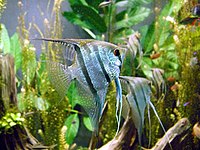
Photo from wikipedia
The present study aimed to experimentally assess Nile tilapia as potential paratenic host of Toxocara spp. A total of 15 Nile tilapia (Oreochromis niloticus) were fed with 300 embryonated Toxocara… Click to show full abstract
The present study aimed to experimentally assess Nile tilapia as potential paratenic host of Toxocara spp. A total of 15 Nile tilapia (Oreochromis niloticus) were fed with 300 embryonated Toxocara canis eggs by oral gavage, while five others of the control group received distilled water. The fish were individually analyzed at 16, 24, 48, 72, and 240 h after inoculation. Water contamination was assessed, and tissue migration by liver, gastrointestinal tract (GIT), eyes, and central nervous system. A murine model was used as the paratenic host for egg infectivity assessment. Eggs and larvae were found in plastic tank water and fish GIT, ranging from 23 to 86% per fish. Eggs and larvae were recovered from the tank water (76.3%) and fish GIT (23.7%). The counting of eggs and larvae observed was negatively correlated with number of eggs and larvae in the water tank (rho = −0.698, p = 0.003). Shedding of embryonated eggs was first detected at 16 and up to 240 h, with significant egg and larvae yield decrease on water-shedding (p = 0.001) and in the GIT (p = 0.007). Although no T. canis larva was recovered in fish tissues, egg infectivity after fish GIT transit was experimentally confirmed by mice assessment. In conclusion, despite shedding viable embryonated eggs through the gastrointestinal tract, tilapias may not play a role as a suitable paratenic hosts for Toxocara spp., posing low risk of zoonotic transmission by fish meat consumption.
Journal Title: Frontiers in Veterinary Science
Year Published: 2021
Link to full text (if available)
Share on Social Media: Sign Up to like & get
recommendations!